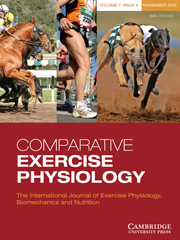Article contents
Comparison of a joint coordinate system versus multi-planar analysis for equine carpal and fetlock kinematics
Published online by Cambridge University Press: 01 February 2008
Abstract
A kinematic multi-planar analysis (MPA) reduces a subject's three-dimensional motion to two-dimensional projections onto planes defined by a fixed global coordinate system (GCS). An alternative to this kinematic method is a joint coordinate system ( JCS) that describes the three-dimensional orientation of the segments comprising the joint with respect to each other so that the JCS moves dynamically with the horse's anatomy. Therefore, the objectives of this study were to locate where differences may occur between the joint motion measurements made using MPA and those made using JCS and to document why these differences in measurements may occur. A Peruvian Paso was recorded during six walking trials using 60 Hz video camcorders. Skin markers tracked the movements and defined the anatomical axes of antebrachial, metacarpal and proximal phalangeal segments. A JCS was established between the two segments comprising the carpal and fetlock joints to measure flexion/extension, internal/external rotation and adduction/abduction at each joint. The MPA model used two markers aligned on the long axis of each segment and measured flexion/extension angles projected onto the sagittal plane of the coordinate system and adduction/abduction angles projected onto the frontal plane of the coordinate system. Carpal and fetlock flexion/extension angles for the walk were similar for the JCS and MPA (peak absolute difference: carpal joint = 7 ± 4° and fetlock joint = 7 ± 2°), indicating that sagittal plane analysis using MPA is adequate when flexion and extension are the only measurements being made provided the horse's plane of motion is aligned with the plane of calibration. There were relatively larger differences in carpal and fetlock adduction/abduction angles measured using an MPA compared with a JCS. Peak absolute difference between the JCS and MPA adduction/abduction angles occurred at 53% of the stride for the carpus (17 ± 4°) and at 61% of the stride for the fetlock (123 ± 25°). Analysis of the reasons for these differences indicated that the accuracy of frontal plane analysis to measure adduction/abduction is limited by its inability to correct for out-of-plane rotations along the long axis of the segments comprising the joint.
Information
- Type
- Research Paper
- Information
- Copyright
- Copyright © Cambridge University Press 2008
References
- 2
- Cited by

